Four recipes from Saint Peter chef Josh Niland's new seafood cookbook
Updated , first published
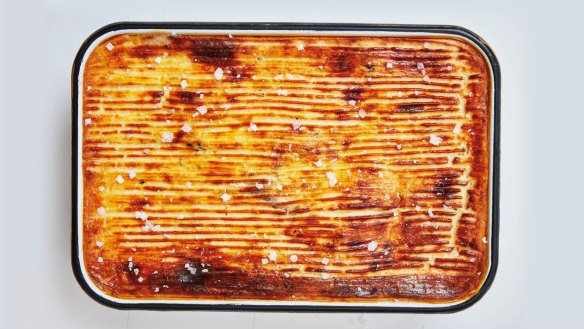
- Changing tide: What Saint Peter chef Josh Niland did next
- Saint Peter chef Josh Niland's tips for buying the best and freshest fish
Fish is so much more than just two fillets held together by a head and a tail, says chef Josh Niland, of pioneering Sydney seafood restaurant Saint Peter. His new cookbook, Take One Fish, combines the scale-to-tail cookery of his first award-winning recipe collection, The Whole Fish Cookbook, with a new maturity and accessibility, showing home cooks how to explore the many culinary possibilities of using whole fish.
Red gurnard, seaweed and dauphine potato pie
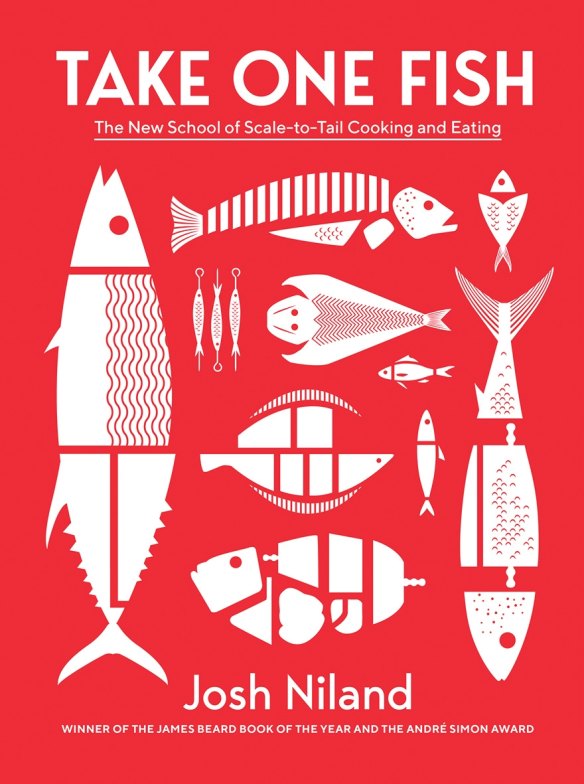
Everything old is new again. I first made this dauphine potato recipe as an apprentice chef; the mashed potato was mixed with choux pastry then spooned into the deep-fryer and cooked until crisp and fluffy. All these years later, I decided it would make the perfect topping for my gurnard and seaweed pie. Red gurnard is the ideal fish for a bechamel-based pie like this; its firm texture, sweetness and rich shellfish characteristics shine through, even beneath the golden potato topping. The seaweed brings a level of complexity and savouriness to the pie that spinach or other green vegetables just can't, so take the time to source the best quality you can find.
INGREDIENTS
- 500ml (2 cups) full-cream milk
- 2 tbsp white miso paste
- 10cm piece of kombu
- 10g bonito flakes
- 50g butter
- 50g (⅓ cup) plain flour
- 20g dried wakame seaweed, softened in cold water
- sea salt flakes and freshly cracked black pepper
- 800g boneless red gurnard fillet, skin on, cut into 3cm chunks
Dauphine potato
- 1kg whole royal blue or Dutch cream potatoes
- rock salt, for cooking
- 50g butter
- 100ml water
- pinch of sea salt flakes
- 100g (⅔ cup) plain flour
- 3 eggs, lightly beaten
- ½ tsp baking powder
- freshly grated nutmeg, to taste
- freshly cracked black pepper
- 1 egg extra, plus 1 egg yolk, lightly beaten to make an egg wash
METHOD
- Whisk the milk, miso, kombu and bonito flakes in a saucepan over a medium heat. Bring the mix up to about 85C and hold over a low heat to keep warm for about 20 minutes.
- In a separate saucepan, melt the butter over a medium heat. Add the flour and cook for 2 minutes or so, stirring with a wooden spoon to form a roux. Remove the strip of kombu from the hot milk and strain off the bonito flakes, then gradually add the strained milk to the roux, one-third at a time, whisking after each addition to create a smooth sauce. When you have incorporated all the milk, bring the sauce to the boil and add the softened wakame. Season to taste, then remove from the heat and closely cover the sauce with plastic wrap or baking paper to stop a skin forming. Refrigerate until completely cold.
- Add the gurnard chunks to the chilled bechamel and combine well, then spoon the filling into a 2.5 litre (10 cup) baking dish or two smaller baking dishes suitable for a pie. Preheat the oven to 170C fan-forced (190C conventional).
- For the dauphine potato, place the washed potatoes on a baking tray covered with a generous layer of rock salt and bake for 1 hour, or until tender when pierced with a skewer or sharp knife. Remove the potatoes from the tray one at a time, then, while hot, scoop out the flesh into a wide-based saucepan. Mash and then stir over a low heat for 1-2 minutes to steam off any excess moisture.
- Increase the oven temperature to 180C fan-forced (200C conventional).
- Place the butter, water and salt in a large saucepan over a low heat until the butter has melted. Increase the heat to medium-high and bring to the boil, then remove from the heat and beat in the flour until well-combined. Set the pan back over a medium heat and beat for a further 2-3 minutes until the mixture comes together and starts to leave the side of the pan. Transfer to a stand mixer fitted with the paddle attachment and beat for 1-2 minutes until the dough is no longer hot but still warm. Add the egg a little at a time, checking the texture of the mixture as you go until it reaches dropping consistency (that is, it should fall very slowly from a spoon when held over the bowl). You may not need all the egg to reach this point.
- Combine the dauphine base with 500g of the warm mashed potato, stir in the baking powder and nutmeg and season liberally with salt flakes and pepper. Scoop the mash into a piping bag and pipe evenly over the filling. Brush the surface lightly with the egg wash, then drag a fork from one end of the pie to the other to create indentations in the potato. Bake for 35 minutes, or until the dauphine potato is crisp and golden. Finish with a sprinkling of salt flakes, then rest the pie for 5 minutes before serving.
Serves 4-6
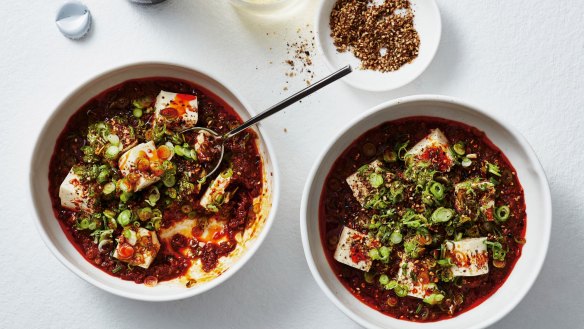
Tuna mapo tofu
Mapo tofu is one of my favourite dishes. The spicy Sichuan ingredients mixed with the minerality and richness of the tuna and the creaminess of the tofu is such a good match. I promise you won't miss the traditional recipe once you've tried this version. Any leftovers make an unbelievable jaffle. The paste can be made in advance and stored in an airtight container in the fridge until needed.
INGREDIENTS
- 1 tbsp Sichuan peppercorns
- 190g fresh ginger, peeled
- 190g garlic cloves, peeled
- 10 French shallots, peeled
- 375g doubanjiang (fermented broad bean paste)
- 300ml grapeseed oil
- 80ml (1/3 cup) Shaoxing rice wine
- 50g caster sugar
- 125ml (½ cup) tamari
- 1 tbsp sesame oil
- 1.8kg minced yellowfin tuna
- 200g silken tofu, cut into small cubes
- 1 bunch spring onions, finely sliced
- 40g (¼ cup) toasted sesame seeds
- 1 dried red chilli, finely sliced (optional)
- steamed short-grain rice, to serve
METHOD
- Toast the Sichuan peppercorns in a dry frypan until fragrant, then use a mortar and pestle to grind to a rough powder. Set aside.
- Place the ginger, garlic, shallots, doubanjiang and 150ml of the grapeseed oil in a food processor and blitz to a smooth paste.
- Heat 100ml of the remaining grapeseed oil in a large heavy-based saucepan over a high heat. Add the paste and fry, stirring occasionally, for 8-10 minutes until dried and fragrant, then reduce the heat and simmer for a further 15 minutes, until the rawness from the vegetables has been completely cooked out. Stir in the Shaoxing wine, sugar, tamari and one-third of the ground Sichuan peppercorns, then spoon the mixture into a large bowl.
- Wipe out the pan, add the sesame oil and remaining 2½ tablespoons of grapeseed oil and heat over a high heat. Working in two batches, add the tuna mince to the pan and fry for 2 minutes, or until the mince is coloured and has separated into individual strands, then stir through the fried paste mixture to combine.
- To assemble the mapo tofu, return the tuna mixture to the saucepan and warm through over a low heat. Add the tofu, cover with a lid and heat for 3 minutes, then spoon into serving bowls. Top with the spring onion, sesame seeds, chilli, if using, and the remaining ground Sichuan peppercorns. Serve with steamed rice, if you like.
Serves 6
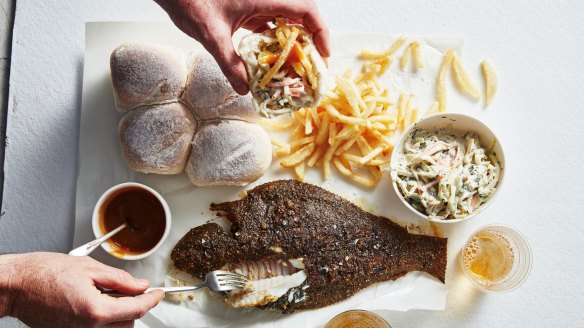
Charcoal flounder with celeriac coleslaw and flounder gravy
This is my interpretation of the classic chicken-shop dinner. From the seasoning added to the flounder to the soft white bread rolls, coleslaw and amazing gravy, this is a dish I hope you will want to cook again and again. Flathead, turbot and halibut all make excellent alternatives here, too. If you have one, use a grill basket specific to cooking flat fish, as it will enable you to flip the fish easily for controlled cooking.
INGREDIENTS
- 2 x 500g whole greenback flounder, gutted and scaled
- 60ml (2 fl oz/ ¼ cup) grapeseed oil
- sea salt flakes
- 4 soft white floury bread rolls, warmed cold butter, for spreading
- flounder gravy, to serve (optional; see recipe)
- fries, to serve (optional)
Flounder seasoning
- 2 tbsp freshly ground fennel seeds
- 2 tbsp freshly ground black peppercorns
- 2 tsp freshly ground cumin seeds
- 2 tsp freshly ground coriander seeds
- 1 tsp onion powder
- 1 tsp garlic powder
- 1 tsp ground turmeric
- 1 tsp cayenne pepper
Celeriac coleslaw
- ¼ red cabbage, finely shredded
- 1 large celeriac, finely sliced
- 2 carrots, finely sliced
- 300g quality mayonnaise
- 60ml (¼ cup) chardonnay vinegar
- sea salt flakes and freshly cracked black pepper
- 1 tsp toasted celery seeds
METHOD
- For the flounder seasoning, combine all the spices in an airtight container and set aside until needed. It will keep in the pantry for up to 1 month.
- To make the celeriac coleslaw, place the cabbage, celeriac and carrot in a large bowl. Whisk together the mayonnaise, vinegar, salt, pepper and celery seeds in a small bowl. Pour about half of the dressing over the salad and toss to combine. Slowly add more dressing until you've reached your desired ratio of coleslaw to dressing. Set aside.
- Prepare a charcoal grill, making sure the grill is hot and the charcoal has cooked down to hot embers. Level out the embers so the heat is even.
- Using scissors, snip off any fins around the skirt of the flounder, as these will be the first things to scorch and become tatty during cooking. Brush the fish on both sides with a little grapeseed oil and season well with salt flakes and the flounder seasoning (about 2 teaspoons for each fish). Place the flounder directly on the grill racks, dark (top) side down, and grill for 4 minutes each side, or until the internal temperature on the bone of the flounder reaches 48C on a probe thermometer.
- Transfer the fish to a large serving platter and leave to rest for 5 minutes. Serve with the coleslaw, warm bread rolls, cold butter, gravy and a generous mound of fries, if you like.
Serves 4
Flounder gravy
Like most of the brown fish stock-based sauces in this book, this one takes the bones of a single species of fish (in this case, the flounder) and roasts them until they are very well caramelised. This step is critical as it lays strong foundations for the sauce. Too much colour will result in a bitter outcome, and not enough will see an insipid, watery gravy. The dark soy and Vegemite round out the sauce, adding deep umami characteristics that can be challenging to extract from fish (as opposed to meat) bones.
To check the viscosity of the reduced sauce, spoon it onto a cool dinner plate to see exactly how thick it is when it cools. This is also a good opportunity to taste it. I realise the abundance of ingredients doesn't give a significant yield, but look at it as the icing on a cake in terms of making a meal complete. And anyway, who doesn't love gravy?
INGREDIENTS
- 100g ghee
- 2 kg flounder frames, gills and guts removed
- 6 large brown onions, finely sliced
- 6 garlic cloves, sliced
- 1 fresh bay leaf
- 15 thyme sprigs
- 300ml white wine
- 2½ tbsp sherry vinegar
- 1 tsp Vegemite
- 1 tsp dark soy sauce
- 750ml (3 cups) brown fish stock (see recipe)
- sea salt flakes and freshly cracked black pepper
METHOD
- Heat the ghee in a large heavy-based saucepan over a medium heat to a light haze, add the flounder bones and caramelise for 10 minutes until well-browned. Add the onion, garlic, bay leaf and thyme and stir to combine. Cook, covered, for 10 minutes, or until the onion is soft and translucent. Remove the lid and cook for a further 10 minutes until the onion is caramelised, then deglaze the pan with the wine and vinegar and simmer until reduced to a syrup. Stir in the Vegemite and dark soy, followed by the fish stock, then bring to a simmer and cook for 20 minutes, or until reduced by half. Season well with salt and pepper.
- Transfer everything to a food processor and blitz to a thickish, coarse sauce (do this in batches if necessary). Pass this liquid through a fine sieve, discarding the solids, then taste and adjust the seasoning. At this point the sauce may need further reducing (see recipe intro); if so, return to a medium heat and simmer for further 5 minutes or until the gravy is thick enough to lightly coat the back of a spoon. It is now ready to serve.
- Store the stock in an airtight container in the fridge for up to a week, or in the freezer for up to a month.
Makes about 250ml (1 cup)
Brown fish stock
To produce a great brown fish stock, try to work with one species of fish rather than a mixture. It's important not to wash your fish bones; soaking a fish frame in water to "purge off the blood" or wash away impurities is backward logic as it only dilutes the qualities of the fish frame. Frames that have been allowed to dry slightly in the fridge overnight will take on colour better and give you greater flavour, as well as being less likely to stick to the pan, so try to take this step where possible.
The ingredients list should only be viewed as a rough guide; the main thing is to follow the proportions indicated by the percentage points. The stocks I make are derived from whatever ingredients I have to hand, so feel free to scale it up or down and substitute flavours as you like. That said, it is important to note that a stock should not be seen as a compost bin that you can throw any scrap into. Be considerate with the quality of ingredients you use as this will be the difference between a good stock and an amazing one.
INGREDIENTS
- ghee or neutral-flavoured oil, for pan-frying
- fish frame pieces (85%)
- evenly chopped vegetables, such as onion, garlic, leek, fennel and celery (10%)
- hard herbs (thyme, rosemary) and toasted savoury aromatics (star anise, fennel seeds, coriander seeds) (up to 5%, depending on the requirements of the stock)
METHOD
- Heat enough ghee or oil in a wide, heavy-based saucepan or stockpot over a high heat to a light haze. Carefully distribute the fish frame pieces around the base, taking care not to overlap them or overcrowd the pan. (Work in batches if necessary.) Cook for about 5 minutes until browned, then remove and set aside.
- Keeping the heat high, add the vegetables and coat well with the fish fat and caramelised scratchings from the base of the pan. Cook for 5-6 minutes, then remove the vegetables and reserve, and discard any oil from the pan. Return the fish frames to the pan, then pour in enough cold water to just cover the ingredients.
- Cook over a medium-high heat, without skimming the surface, for 15-20 minutes. Return the par-cooked vegetables to the pan, along with any aromatics you are using, and cook for a further 10 minutes or until the liquid has reduced by half and developed a beautiful tan colour.
- This lack of skimming may go against the grain, but the impurities that rise to the surface have a lot of flavour and I prefer a richer, more viscous stock to one with less intensity. Adding the vegetables and aromatics to the stock in the later stages of cooking results in a cleaner profile, allowing the individual ingredients to be articulated rather than tasting one-dimensional.
- Pass through a fine mesh sieve, discarding the solids. This stock is now ready to be used as a base for making sauces. Store the strained stock in airtight containers in the fridge for up to 4 days or freeze in portions for up to 2 months.
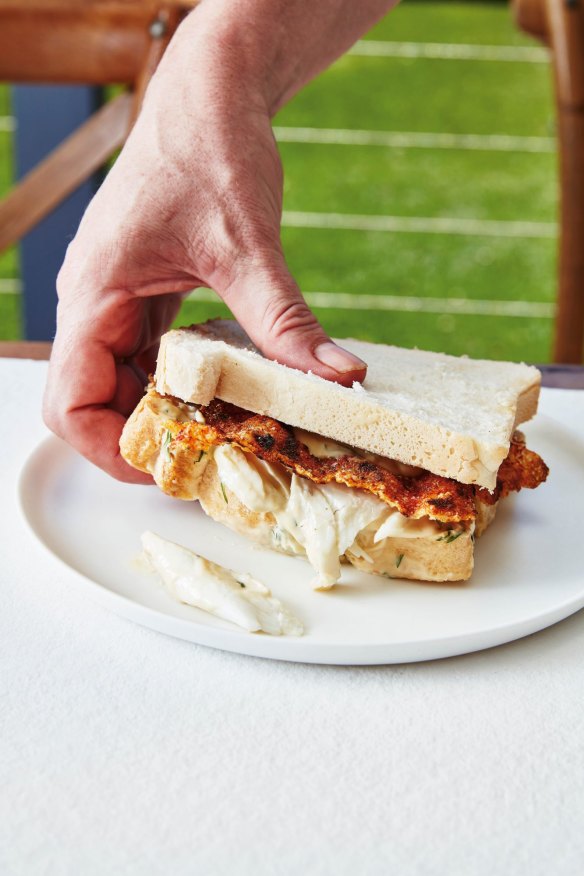
Coral trout, crisp skin and tarragon mayonnaise sandwiches
Firstly, I agree, this is an extensive recipe for a sandwich but if something's worth doing … Certainly, you can make a quick version by simply poaching the coral trout, shredding the flesh and adding the seasonings below, but if you do commit to this recipe as it is written, the result will be texturally far superior, as the crisp skin between the soft bread slices is pure heaven. This is a phenomenal sandwich for a weekend lunch with friends – great with crisps and a pickle! Or make them smaller and serve as canapes at your next gathering.
The reason for using two cooking methods here is to create a very crisp skin by pan-frying and then a silky, moist flesh by poaching in ghee. Placing a small wrapped plate in the base of your poaching pan will help you achieve an even result on both the top and bottom of the fillet.
INGREDIENTS
- 500g ghee
- 2 tsp toasted fennel seeds
- 1 star anise
- 1 x 320g boneless coral trout fillet, skin on
- sea salt flakes and freshly cracked black pepper
- 8 slices of fresh white bread
Tarragon mayonnaise
- 2 egg yolks
- 2 tsp dijon mustard
- 2 tsp apple-cider vinegar
- 150ml olive oil
- 100ml grapeseed oil
- 1 tbsp lemon juice
- sea salt flakes and freshly cracked black pepper
- 1 bunch tarragon, leaves picked and finely chopped, stems reserved
METHOD
- To make the mayonnaise, whisk together the egg yolks, mustard and vinegar in a bowl. While continuing to whisk, slowly add the two oils to emulsify. Add the lemon juice and season to taste, then stir in the tarragon leaves to finish. Set aside.
- Take a small flat saucer or plate and wrap it in plastic wrap so that it is taut from edge to edge. Place the wrapped plate in the bottom of a large saucepan – it should fit comfortably with plenty of room for easy removal later. Add the ghee, fennel seeds, star anise and reserved tarragon stems and place over a low heat. Bring to a steady temperature of 48C.
- Heat 60ml (¼ cup) of the infused ghee in a cast-iron skillet or frypan over a high heat to a light haze. Put the fillet in the pan, place a fish weight or small saucepan on top and cook for 2 minutes, or until you see colour around the edges. Use an offset palette knife to lift up the fillet and move it to a clean surface in the pan. Cook the weighted fillet for another minute, or until the skin is golden brown and crisp but the flesh is still very raw and cool. Remove from the pan and, using a sharp knife, carefully cut the skin from the flesh. Set the skin aside on a wire rack to cool.
- Lower the partially cooked fillet into the warm infused ghee so that it is completely submerged and leave it to poach for 10 minutes, then remove the pan from the heat and leave the fish to stand in the ghee for a further 4 minutes. Remove from the ghee and rest on the wire rack for 5 minutes.
- While the coral trout is resting, place 2½ tablespoons of the infused ghee in the skillet or frying pan and heat over a medium heat to a light haze. Add the skin, underside down, and cook carefully, without letting it burn, for another 30-60 seconds to add more colour and crispness. Season with salt and set aside. Cut into four even pieces.
- Carefully pull the rested fillet into large pieces and place in a bowl. Add a few tablespoons of the mayonnaise and salt and pepper to taste, and gently stir together. Spoon the mixture onto four slices of bread and position the crisp skin on top. Sandwich with the remaining bread slices and serve as a whole square so you don't have to share!
Note: Any leftover mayonnaise will keep in an airtight container in the fridge for up to 4 days.
Serves 4
This is an edited extract from Take One Fish by Josh Niland, published by Hardie Grant Books, RRP $55, available in stores nationally. Photography: Rob Palmer. Buy now
Appears in these collections
From our partners
Original URL: https://www.theage.com.au/goodfood/four-recipes-from-saint-peter-chef-josh-nilands-new-seafood-cookbook-20210715-h1x6f2.html